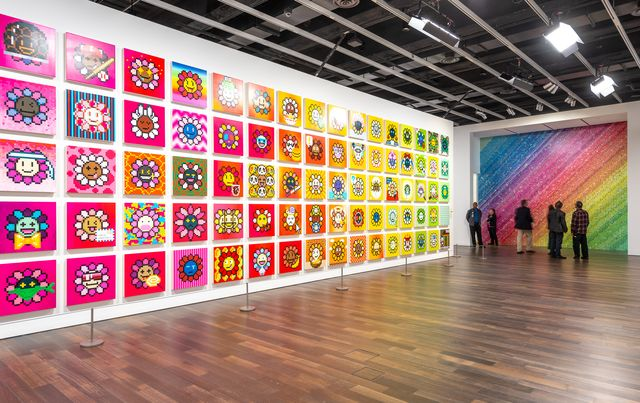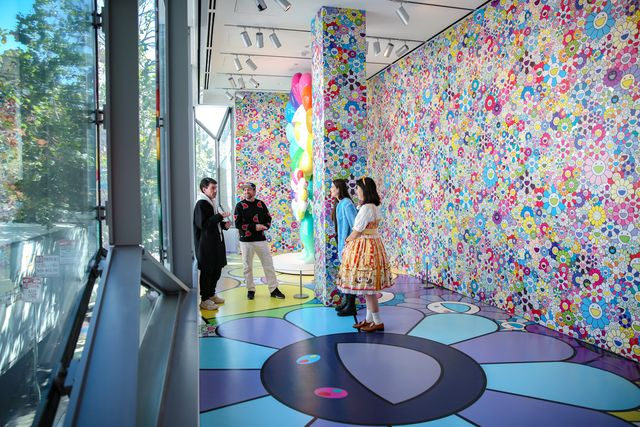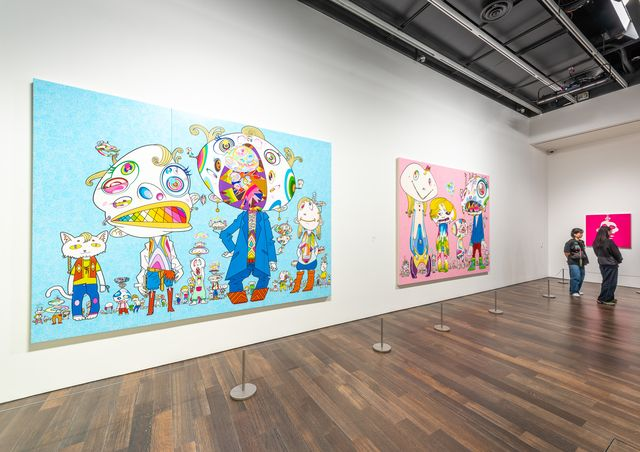
Photos courtesy of of The Asian Art Museum
Guided along a trail of flowers, visitors to the Asian Art Museum might believe they’re seeing romantic rose petals. However, these are the cheery rainbow creations of Japanese artist Takashi Murakami. An artist who began as an anime fan in 1980s Japan and now has a Ph.D. in Nihonga, a Japanese style of painting, Murakami has made a name for himself in the art world by combining high and low art, cute and ugly, and old and new in his Superflat art movement, a postmodern art movement. Even if you haven’t heard of the artist, you may have seen his flowers, now an iconic symbol of his brand after his collaboration with fashion company Louis Vuitton in 2003.
“Takashi Murakami: Unfamiliar People – Swelling of Monsterized Human Ego” begins with a nod to Murakami’s laureled portfolio, including “727” or “Tan Tan Bo Black Hole,” but it is mainly a reflection of the artist’s attitudes toward the current world, explored retrospectively in “Beyond the 727” and progressively in his collection of NFT pieces.

“727” is composed of three panels, coming together to form a picture of Takashi’s original character Mr. DOB floating on a cloud, his crazy smile revealing a set of sharp teeth. The piece depicts Takashi’s cynicism towards Western influence, the appearance of Mr. DOB reminding viewers of the Disney symbol Mickey Mouse and the title “727” referencing a Japanese cosmetics brand that he believed copied the name from American Boeing-727 airplanes.
Even if you haven’t heard of the artist, you may have seen his flowers, now an iconic symbol of his brand after his collaboration with fashion company Louis Vuitton in 2003
The deceptively innocent but cruel mascot, Mr. DOB, thus represents Japanese pop culture’s drastic shift into infantility after WW2, which Murakami believed to be brought on by US influence.
However, his reflection on the piece 20 years later reveals a more optimistic perspective. “Beyond the 727” reinvents the meaning of the number. Murakami wonders in a letter written on the canvas that perhaps because 727 coincidentally happens to be a rare prime number, his painting unknowingly marked his unique and magical artistic career.
Visitor Calvin Hong notes the significant use of color in the piece.
“This exhibition is so profound with [his] use of color, imagery, and his whole persona,” Hong said. “[Murakami has] insight from when he was a child, in the days of when growing up was dark … This is an expression of him coming out of that darkness [with] the use of color [and] imagery.”

The biggest painting in the entire exhibition is “Judgemen Day.” This 82-foot-long painting takes inspiration from Ukiyo-e, a Japanese art movement from the Edo Period. Ukiyo-e prints focused on courtesans, kabuki actors and landscapes, and were designed to be mass-produced, similar to how Murakami makes his artwork accessible to a wide audience. In the center of “Judgement Day” sits an old emperor almost as tall as the canvas on a red throne, while men wearing mawashi, sumo wrestling belts, grapple at each other, forming an entangled knot around the huge figure. Rushing waves of rainbow erupt on both sides, carrying ships and yōkai, supernatural entities in Japanese folklore. On one side of the painting is a group of courtesans entertaining a man made of melded human bodies. On the other are two men with swords, one with a tattooed back, suggesting his rebellious nature as tattoos were commonly associated with criminals in the time period. Every person in the painting wears a delirious expression, with psychedelic rainbow eyes lolling in different directions.
“I created [this painting] by mixing the monstrosity of human beings I felt through the [COVID-19] pandemic with the strange imageries of Ukiyoe,” Murakami said on his Instagram.
In his painting, traditional Japanese subjects are depicted at their worst, with lustful patrons, feral warriors and monstrous seas representing the disorder in the world after the pandemic. The king calmly sits in the center of this chaos, looking toward and seemingly judging the viewer.
Visitors linger at this wall, trying to understand, but mostly admiring the masterful use of color and storytelling.
They’ll point to their favorite ones and say ‘Mom, I want this one …’ They’ll even draw [them with] their little notepads
“[Murakami] is breaking down the barriers between so-called high art and low art,” said visitor and cartoonist DW. “My mom might look at something I did and say ‘I’m worried that I don’t get it.’ I’ll say, ‘Did you think it was a pretty picture? Then you got it … ’ Even something that has depth and power and layers of meaning to it should [allow] any person who has never seen that kind of thing before … to find something useful in it.”
In the center of the exhibition, visitors can walk into a room covered in Murakami’s flowers. One wall is covered with icons of charismatic pixelated rainbow flowers—from an orange and red flower blowing bubble gum to a pink-petaled flower showing off golden grills.

“The little kids love these flowers,” said the museum’s security guard Alexis Guillen. “They’ll point to their favorite ones and say ‘Mom, I want this one …’ They’ll even draw [them with] their little notepads.”
This area encourages visitors to take photos immersed in its rainbow fantasy. On the other side of the wall is written: “WEIRDLY LOVABLE, LOVABLY WEIRD” in glowing neon red letters. This phrase can be applied to Murakami’s entire portfolio, but by posing under it, visitors are playfully integrated into the exhibition as they apply that phrase to themselves.
In the final corridor sits the titular painting “Unfamiliar People.” These pieces focus on the effect of technology on younger generations, especially after the pandemic. In “Unfamiliar People,” four large figures stand at the forefront. They wear melting clothes and monstrously morphed expressions, with rainbow teeth and eyes for nostrils. In this painting, Murakami hoped to express how the isolation during COVID-19 brought out the most polarized and shocking sides of human nature, “monsterizing” everyday people.
One thing is for certain, his cynicism wrapped up in a bow of naivete is hard to look away from
Throughout all of “Unfamiliar People,” in Murakami’s exhibit at the Asian Art Museum, the artist is infatuated with how our culture influences our humanity. His Asian Art Museum exhibit begins with his present in “727,” then the past in “Judgement Day,” ending it with a look to the future with “Unfamiliar People.” One thing is for certain, his cynicism wrapped up in a bow of naivete is hard to look away from.




